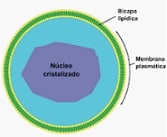Peroxisoma is a term that is not part of the dictionary of the Royal Spanish Academy ( RAE ). Specifically, it is considered that the etymological origin of the term in question derives from Greek. Thus, it is the result of the sum of two elements of said language: the element “but-”, which comes from “peroxide”, and the word “soma”, which can be used as a synonym for “body”.
The concept is used to name an organelle in the cytoplasm that houses various oxidative enzymes such as peroxidase and catalase .
 Peroxisomes are surrounded by a membrane and are present in all eukaryotic cells . They were discovered by the Englishman Christian de Duve ( 1917 – 2013 ) and his work team.
Peroxisomes are surrounded by a membrane and are present in all eukaryotic cells . They were discovered by the Englishman Christian de Duve ( 1917 – 2013 ) and his work team.
In the same way, we cannot ignore that there are two enzymes that are typical of the peroxisome. We are referring to urate oxidase and the so-called catalase.
The oxidation of amino acids and fatty acids is part of the functions of peroxisomes, which may have crystalline structures called crystalloids or nucleoids inside. They are also responsible for catabolizing purines and eliminating hydrogen peroxide , a secondary product that originates when certain toxic substances are degraded (which is why peroxisomes, in the kidneys and liver, are said to be involved in detoxification reactions ).
Spherical in shape, the peroxisome does not have ribosomes attached to its structure or its own genome. There is a single membrane around it, unlike what happens with chloroplasts and mitochondria .
Another interesting fact about peroxisomes is that they are able to change their enzymatic composition according to various factors , such as environmental conditions or cell type. This means that there is a wide variety of these organelles.
A yeast that grows in an environment with a high level of fatty acids, to mention one case, has larger peroxisomes than other yeast located next to carbohydrates. This is due to the different oxidation needs.
Among the curiosities known about the peroxisome is the fact that its origin is considered to be in an ancient organelle. More precisely, one that was present in the primitive ancestors of eukaryotic cells and whose main function was to undertake oxygen metabolism.
It is also interesting to know that, sometimes, what is known as an inborn error of peroxisome metabolism can occur. This can take place when a mutation occurs in a gene that is responsible for encoding proteins.
What's more, this aforementioned error can occur directly in the functions of peroxisomal enzymes or in what is called biogenesis.
Finally, among the most significant peroxisomal diseases are rhizomyelic chondrodysplasia punctata type I, the so-called CDPR, which brings with it alterations in different functions, and the Zellweger spectrum. This includes childhood Refsum disease and Zellweger syndrome.
